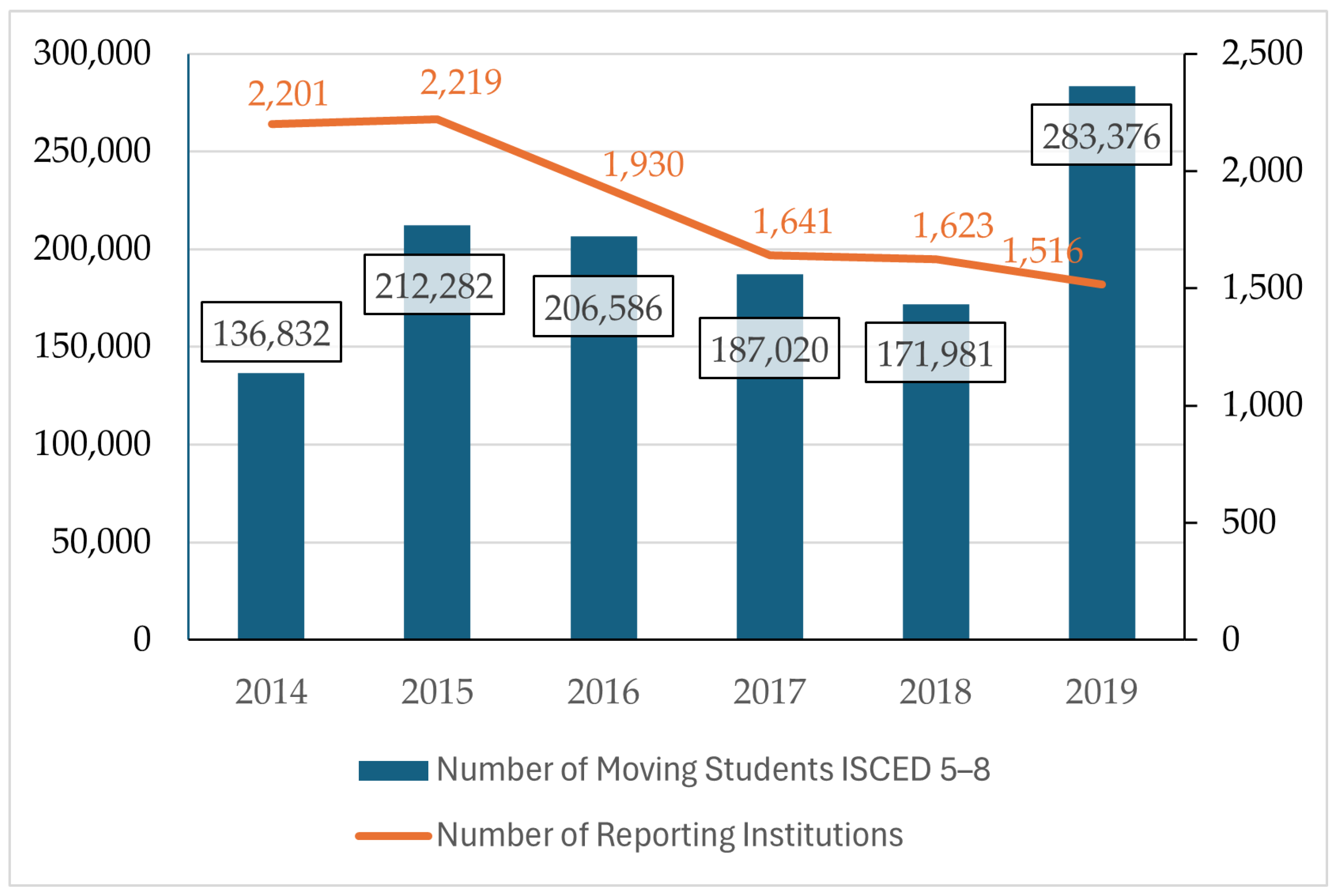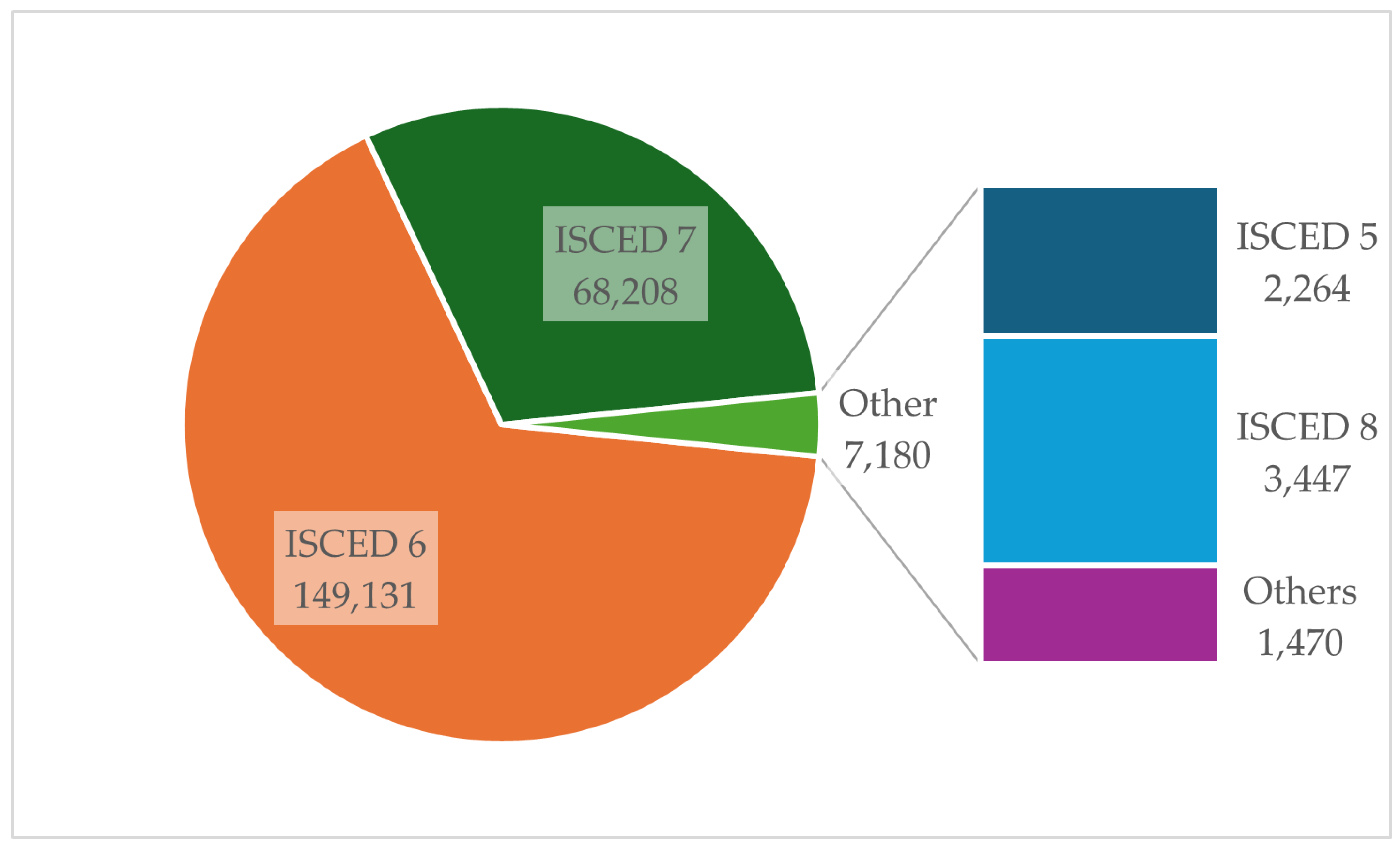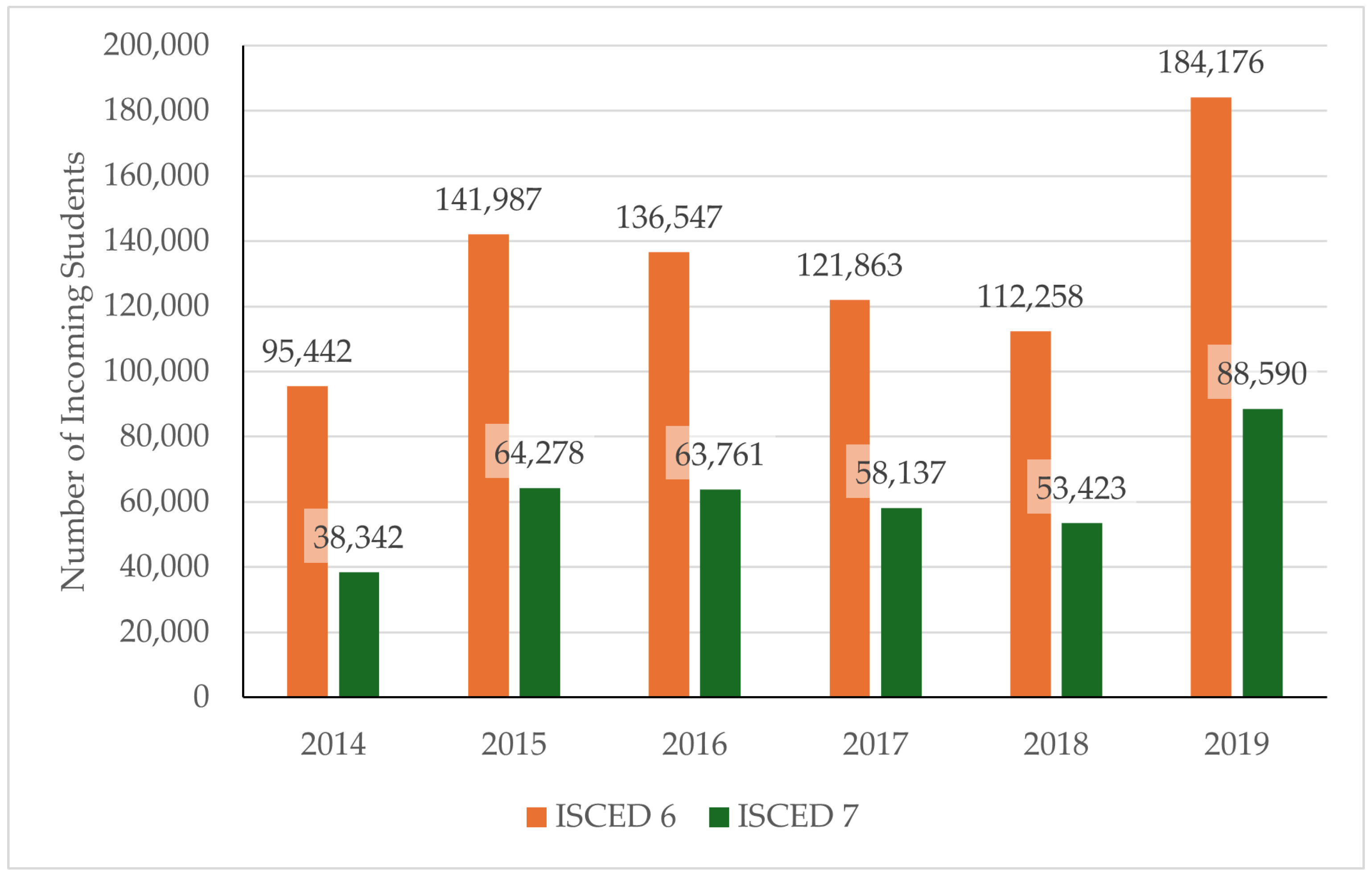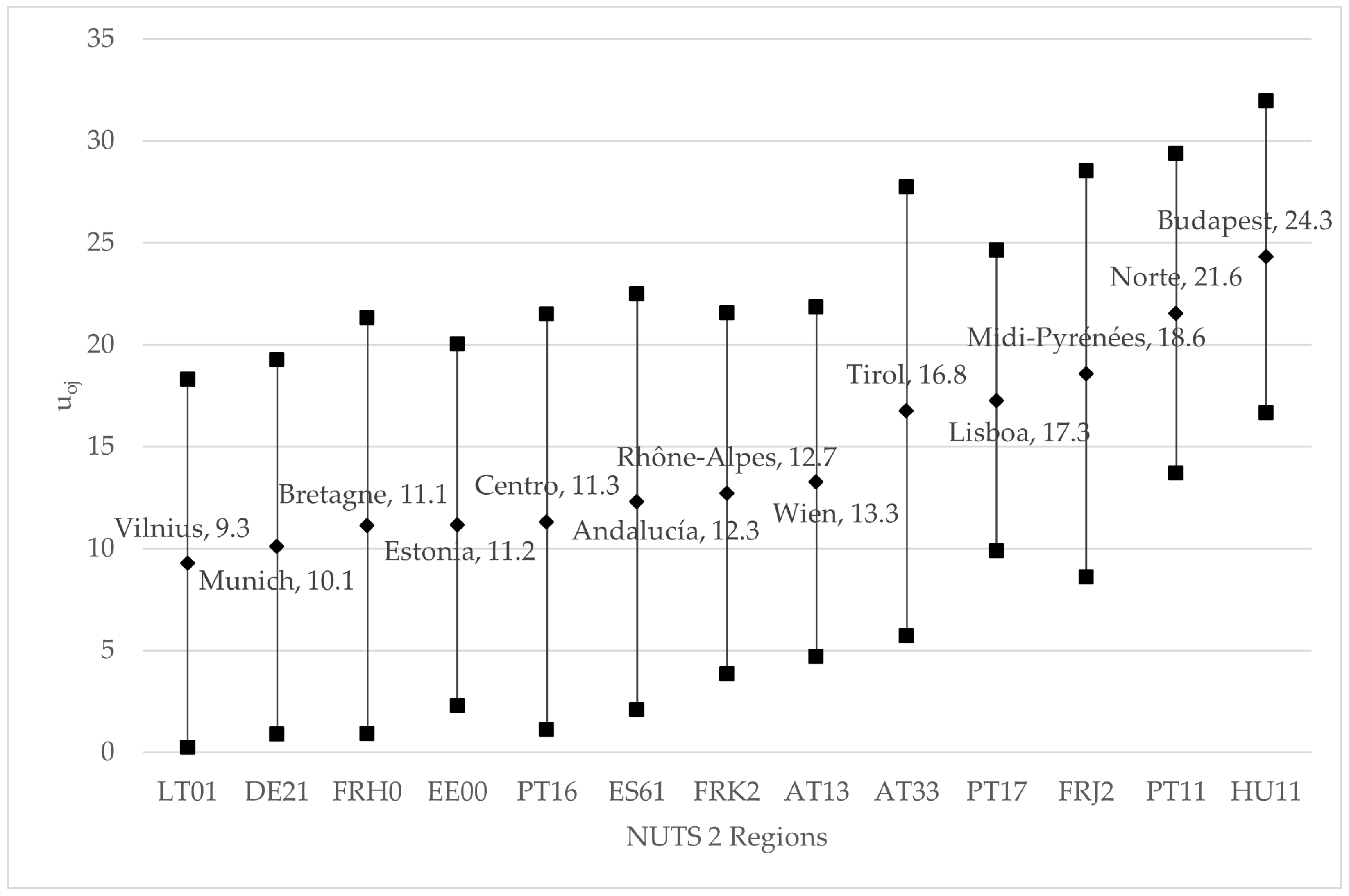Regional Pathways to Internationalization: The Role of Erasmus+ in European HEIs
Abstract
1. Introduction
2. Literature, Data, Methods, and Hypotheses
2.1. Literature Review
2.2. Data
2.3. Methods
2.3.1. Hotspot Analysis
2.3.2. Multilevel Analysis
2.4. Hypotheses
3. Results
3.1. The Geography of Erasmus Incoming Students
3.2. A Model of the HEI and Regional Factors Affecting Student Mobility
4. Discussion and Regional Policy Implications
5. Conclusions
Author Contributions
Funding
Institutional Review Board Statement
Data Availability Statement
Conflicts of Interest
References
- Cattaruzzo, S.; Corò, G. Understanding Erasmus Mobility in European Regions: A Quantile-Based Approach; Working Papers No. 25/WP/2023; Department of Economics, Ca’ Foscari University of Venice: Venice, Italy, 2023; Available online: https://ssrn.com/abstract=4619859 (accessed on 9 September 2024).
- Barrioluengo, S.M.; Flisi, S. Student Mobility in Tertiary Education: Institutional Factors and Regional Attractiveness; Publications Office of the European Union: Luxembourg, 2017. [Google Scholar] [CrossRef]
- Lepori, B.; Seeber, M.; Bonaccorsi, A. Competition for talent. Country and organisational-level effects in the internationalisation of European higher education institutions. Res. Policy 2015, 44, 789–802. [Google Scholar] [CrossRef]
- Nogueiro, T.; Saraiva, M.; Jorge, F.; Chaleta, E. The Erasmus+ Programme and Sustainable Development Goals—Contribution of mobility actions in higher education. Sustainability 2022, 14, 1628. [Google Scholar] [CrossRef]
- Kirloskar, P.; Inamdar, N. Shifting international student mobility directions and factors influencing students’ higher education destination choices. J. High. Educ. Policy Leadersh. Stud. 2021, 2, 160–178. [Google Scholar] [CrossRef]
- Gutema, D.M.; Pant, S.; Nikou, S. Exploring key themes and trends in international student mobility research: A systematic literature review. J. Appl. Res. High. Educ. 2023, 15, 843–861. [Google Scholar] [CrossRef]
- European Commission. Erasmus+ 2021–2027: Enriching Lives, Opening Minds Through the EU Programme for Education, Training, Youth and Sport; Directorate-General for Education, Youth, Sport and Culture, Publications Office of the European Union: Luxembourg, 2021; Available online: https://op.europa.eu/en/publication-detail/-/publication/ff1edfdf-8bca-11eb-b85c-01aa75ed71a1/language-en (accessed on 1 October 2024).
- Brunazzo, M. Human resources and sustainable development in the EU: The case of the Erasmus+ Program. In Proceedings of the ICPT.HUST 2023—International Conference on Human Resources for Sustainable Development, Hanoi, Vietnam, 14–15 December 2023; pp. 134–146. [Google Scholar] [CrossRef]
- Kosztyán, Z.T.; Kiss, D.; Obermayer, N. Investigating Erasmus mobility exchange networks with gravity models. Cogent Soc. Sci. 2023, 9, 2253612. [Google Scholar] [CrossRef]
- Gadár, L.; Kosztyán, Z.T.; Telcs, A.; Abonyi, J. A multilayer and spatial description of the Erasmus mobility network. Sci. Data 2020, 7, 41. [Google Scholar] [CrossRef]
- Gadár, L.; Kosztyán, Z.T.; Telcs, A.; Abonyi, J. Cooperation patterns in the ERASMUS student exchange network: An empirical study. Appl. Netw. Sci. 2022, 7, 74. [Google Scholar] [CrossRef]
- Souto-Otero, M.; Gehlke, A.; Basna, K.; Dóka, Á.; Endrodi, G.; Favero, L.; Humburg, M.; Jantoš, M.; Key, O.; Oberheidt, S.; et al. Erasmus+ Higher Education Impact Study; Project Report; Publications Office of the European Union: Luxembourg, 2019. [Google Scholar] [CrossRef]
- Álamo-Vera, F.R.; Hernández-López, L.; Ballesteros-Rodríguez, J.L.; De Saá-Pérez, P. Competence development and employability expectations: A gender perspective of mobility programmes in higher education. Adm. Sci. 2020, 10, 74. [Google Scholar] [CrossRef]
- Iriondo, I. Evaluation of the impact of Erasmus study mobility on salaries and employment of recent graduates in Spain. Stud. High. Educ. 2020, 45, 925–943. [Google Scholar] [CrossRef]
- Goksu, F. Intercultural mobility and European identity: Impact of the Erasmus Exchange Programme in terms of cultural differences. Cent. Eur. J. Commun. 2020, 1, 77–92. [Google Scholar] [CrossRef]
- Mitchell, K. Rethinking the ‘Erasmus Effect’ on European Identity. J. Common Mark. Stud. (JCMS) 2015, 53, 330–348. [Google Scholar] [CrossRef]
- Bliese, P.D. Group size, ICC values, and group-level correlations: A simulation. Organ. Res. Methods 1998, 1, 355–373. [Google Scholar] [CrossRef]
- Musca, S.C.; Kamiejski, R.; Nugier, A.; Méot, A.; Er-rafiy, A.; Brauer, M. Data with hierarchical structure: Impact of intraclass correlation and sample size on Type-I error. Front. Psychol. 2011, 2, 74. [Google Scholar] [CrossRef]
- Nakagawa, S.; Schielzeth, H. A general and simple method for obtaining R2 from generalised linear mixed-effects models. Methods Ecol. Evol. 2013, 4, 133–142. [Google Scholar] [CrossRef]
- Rodríguez González, C.; Bustillo Mesanza, R.; Mariel, P. The determinants of international student mobility flows: An empirical study on the Erasmus programme. High. Educ. 2011, 62, 413–430. [Google Scholar] [CrossRef]
- Birch, C.; Lichy, J.; Mulholland, G.; Kachour, M. An enquiry into potential graduate entrepreneurship: Is higher education turning off the pipeline of graduate entrepreneurs? J. Manag. Dev. 2017, 36, 743–760. [Google Scholar] [CrossRef]
- Čajka, P.; Rybakova, A.; Alieva, L.; Shcheglova, A. Regional concentration of higher education. E3S Web Conf. 2021, 301, 03009. [Google Scholar] [CrossRef]
- Brekke, T. What do we know about the university contribution to regional economic development? A conceptual framework. Int. Reg. Sci. Rev. 2021, 44, 229–261. [Google Scholar] [CrossRef]
- Anastasiou, E.; Karkanis, D.; Kalogiannidis, S.; Konteos, G. Building European cities, shaping economies: The roles of infrastructure and demographics in urban economic performance (2017–2022). Urban Sci. 2024, 8, 263. [Google Scholar] [CrossRef]
- Agasisti, T.; Bertoletti, A. Higher education and economic growth: A longitudinal study of European regions 2000–2017. Socioecon. Plann. Sci. 2022, 81, 100940. [Google Scholar] [CrossRef]
- Eliasson, K.; Haapanen, M.; Westerlund, O. Regional concentration of university graduates: The role of high school grades and parental background. Eur. Urban Reg. Stud. 2020, 27, 398–414. [Google Scholar] [CrossRef]
- Perez-Encinas, A.; Rodriguez-Pomeda, J.; de Wit, H. Factors influencing student mobility: A comparative European study. Stud. High. Educ. 2021, 46, 2528–2541. [Google Scholar] [CrossRef]
- Shapiro, J.M. Smart Cities: Quality of Life, Productivity, and the Growth Effects of Human Capital; NBER Working Paper No. 11615; National Bureau of Economic Research: Cambridge, MA, USA, 2005; Available online: http://www.nber.org/papers/w11615 (accessed on 1 October 2024).





| Variable Name | Definition | Data Source | Mean | Standard Deviation | Number of Valid Cases |
|---|---|---|---|---|---|
| Dependent Variables | |||||
| D_Erasmus_rate_all | ETER | 16.885 | 25.2537 | 2066 | |
| D_Erasmus_rate_6 | ETER | 63.746 | 813.342 | 1970 | |
| D_Erasmus_rate_7 | ETER | 28.441 | 81.727 | 1902 | |
| Independent HEI Level Variables | |||||
| I1_Teaching_Load | ETER | 10.846 | 12.316 | 1816 | |
| I2_Fees | ETER | 2,128.6 | 3542.7 | 1237.0 | |
| I3_Research_intensity | ETER | 0.041 | 0.731 | 1983 | |
| I4_Research_excellence | CWTS | 0.025 | 0.054 | 2066 | |
| I5_Research_reputation | ETER | 1.246 | 13.696 | 1970 | |
| Control HEI Level Variables | |||||
| C1_Size | Total number of 1000 students ISCED 5–8 | ETER | 7.605 | 1.107 | 2041 |
| C2_Decentralisation | Dummy variable, 1 = multi campus HEI, 0 = single campus | ETER | 0.277 | 0.448 | 2065 |
| C3_Legal | Dummy variable, 1 = public or government supported HEI, 0 = all other legal forms | ETER | 0.262 | 0.440 | 2054 |
| Regional Context Variables | |||||
| R1_Urban | Population density of the NUTS2 region in which the HEI is established (inhabitants per km2) | Eurostat demo_r_d3dens | 711.931 | 1608.062 | 2038 |
| R2_Employment_rate | The employment rate of the NUTS2 population aged 20–34 who have completed tertiary education one to three years before the reference year and who are no longer in education or training | Eurostat edat_lfse_33 | 83.687 | 11.686 | 2025 |
| R3_Regional_earnings | The compensation received by the employees is recorded in the allocation of the primary income account of households divided by the number of employees, in thousand euros | Eurostatnama_10r_2hhinc and nama_10r_2emhrw | 20.729 | 11.396 | 1910 |
| R4_Educat_Attainments | The proportion of higher education graduates in the population | Eurostatedat_lfse_04 | 43.389 | 12.444 | 2058 |
| R5_Research_excellence | % of the academic publications of the HEIs in the region that are in the top 1% of most cited publications | CWTS | 1.688 | 0.614 | 1794 |
| Model 1 (The Null Model) | Model 2 | Model 3 | Model 4 | Model 5 | |
|---|---|---|---|---|---|
| Dependent variable | Erasmus_rate_all | Erasmus_rate_all | Erasmus_rate_all | Erasmus_rate_6 | Erasmus_rate_7 |
| Fixed effects—HEI specific | |||||
| I1_Teaching_Load | −0.308 *** | −0.354 *** | −4.647 | −0.209 | |
| I2_Fees | 0.688 ** | --- | --- | ||
| I3_Research_intensity | 0.264 | 0.015 | 2.767 | 0.715 ** | |
| I4_Research_excellence | 41.436 ** | 37.126 ** | −13.683 * | 0.897 | |
| I5_Research_reputation | 0.817 ** | 0.625 ** | 55.691 *** | −1.706 | |
| C1_Size | −0.255 ** | −0.157 ** | −3.901 | −0.586 * | |
| C2_Decentralisation | −1.072 | −1.091 | 19.578 | 5.467 | |
| C3_Legal | −3.364 | 1.054 | −39.263 | −0.513 | |
| Fixed effects—region specific | |||||
| R1_Urban | 3.797 × 10−5 | 0.001 | −0.033 | −0.003 | |
| R2_Employment_rate | 0.062 | 0.045 | −4.726 | 0.022 | |
| R3_Regional_earnings | −0.360 ** | −0.206 | 13.803 ** | −0.649 | |
| R4_Educat_Attainments | 0.178 ** | 0.252 ** | 9.899 ** | 0.808 ** | |
| R5_Research_excellence | 6.184 ** | 3.345 | −104.704 | 19.075 * | |
| Constant | 15.763 *** | 2.977 | 2.176 | −32.031 | −16.929 |
| Statistics | |||||
| −2 Log-likelihood | 19,110.109 | 7588.362 | 12,357.132 | 20,091.618 | 13,659.942 |
| ) | 0.087 | 0.195 | 0.162 | 0.158 | 0.111 |
| HEIs (level 1 observations) | 2066 | 860 | 1355 | 1312 | 1271 |
| Regions (level 2 observations) | 277 | 123 | 154 | 154 | 154 |
Disclaimer/Publisher’s Note: The statements, opinions and data contained in all publications are solely those of the individual author(s) and contributor(s) and not of MDPI and/or the editor(s). MDPI and/or the editor(s) disclaim responsibility for any injury to people or property resulting from any ideas, methods, instructions or products referred to in the content. |
© 2025 by the authors. Licensee MDPI, Basel, Switzerland. This article is an open access article distributed under the terms and conditions of the Creative Commons Attribution (CC BY) license (https://creativecommons.org/licenses/by/4.0/).
Share and Cite
Georgoudaki, E.; Stavropoulos, S.; Skuras, D. Regional Pathways to Internationalization: The Role of Erasmus+ in European HEIs. Urban Sci. 2025, 9, 144. https://doi.org/10.3390/urbansci9050144
Georgoudaki E, Stavropoulos S, Skuras D. Regional Pathways to Internationalization: The Role of Erasmus+ in European HEIs. Urban Science. 2025; 9(5):144. https://doi.org/10.3390/urbansci9050144
Chicago/Turabian StyleGeorgoudaki, Eleni, Spyridon Stavropoulos, and Dimitris Skuras. 2025. "Regional Pathways to Internationalization: The Role of Erasmus+ in European HEIs" Urban Science 9, no. 5: 144. https://doi.org/10.3390/urbansci9050144
APA StyleGeorgoudaki, E., Stavropoulos, S., & Skuras, D. (2025). Regional Pathways to Internationalization: The Role of Erasmus+ in European HEIs. Urban Science, 9(5), 144. https://doi.org/10.3390/urbansci9050144







